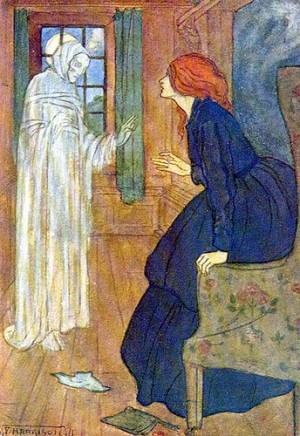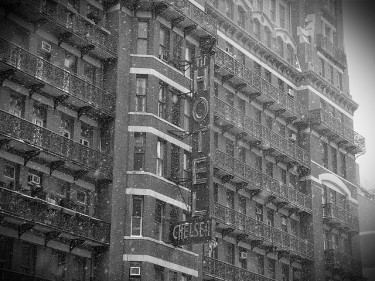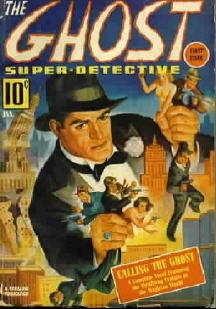"I Met A Ghost!" Five Chilling Real-Life Tales!

Yes, it’s hot outside. It’s summer, so hopefully no one is shocked by that. But it’s still awful, a travail that everyone expects but nobody likes. But do you know what’s cold? Or, what will be cold in a short minute? Your blood will be cold, because we have gathered legitimately scary ghost stories guaranteed actually to have happened! And they’re scary!
They’re not as good as central air, or winter, but it is you, the reader, that we love, and one small way we can show our appreciation is to scare you with real-life stories of the unexplained to the extent that you forget about your earthly-plane problems, like sweating and dehydration. The stories are from writers Cusi Cram, Emily Rems, Christopher Conry, Lori Horvitz and me. Enjoy (if that’s the appropriate response to actually scary things).
Cusi Cram
My mother is from Scotland, and there’s a castle in her family. She wasn’t raised there but her father inherited it when she was in her twenties and she grew up going there every summer. It’s a very castley-castle, with turrets by a loch in the western highlands. The castle is apparently very, very haunted. Her family has been in that part of the world, more or less in the same place, since the 12th century. So that means there has been plenty of time for a variety ghosts from lots of different periods in history to settle in and set up shop.
Now when I was very small, she didn’t really tell me about all the ghosts, knowing that when we would come from New York to visit her family, no little kid wants to go stay in a haunted castle.

One time we were there, and I was six, about the age when you have imaginary friends. Or I did, at least. And I had a lot of them, and they were very active and social. Someone in the group was always getting married, or throwing a ball of some kind. It was an interspecies group; there was bear named Fred, who was the ringleader and lots of beautiful woman with Italian names like Francesca and Mary Luca and a family of royal cats.
There was a garden at the castle, and the garden was kind of French, with very tall manicured shrubs. I was there with my usual non-existent crew, having a little picnic to celebrate someone’s wedding. And then I saw this lady, who I had never seen before. And she was grey, completely grey, and dressed in Victorian clothes. Not that I would’ve been able to say that at the time. I think I thought they were “old fashioned” clothes. And she was sort of roaming around the garden, almost gliding, as if she didn’t have feet under her petticoats.
I think I kind of acknowledged her, but I was having a picnic with my friends who looked a lot more fun than her, and for some reason I did not invite her to sit down. I watched her watch us, and then she suddenly disappeared.
It was a strange feeling, because, as a child, you’re in charge of your own imagination. But this time it was in charge of me.
Anyway, I went inside and I spoke to my mother. I told her “I was having a picnic with my friends, my imaginary friends, and there was this woman there, and she was all in grey, and I know she wanted to sit down with us, and I didn’t feel like asking her.” My mother’s face went totally white. I said, “What, what’s wrong?”
My mother, in a very dramatic British accent said, “You’ve seen the Grey Lady in the garden.” And I said, “What’s that, what’s that?” And she told me about the ghosts that had been seen around the castle for centuries and that the Grey Lady was one of the most famous ones.
And suddenly I realized that what I’d seen was a ghost, I hadn’t made her up. And then my mother, perhaps not very perspicaciously, read me diary entries of ancestors and other people describing the Grey Lady. I tried to figure out who she was and where she came from. I can’t remember many of the details about her but she did have a complicated, sad story like most ghosts. If I remember correctly, she died in childbirth and she was named Elisabeth. No one seemed to know why she was gray.
Over the years when I went back to visit, I’d feel things, spirits, chills, doors would suddenly close, sometimes I would hear voices of people who weren’t there. I became very aware that the castle had this whole other set of inhabitants. Even now when I go back to visit, I find it extremely hard to sleep at night.
I’ve looked for the Grey Lady again but ghosts seem to play by their own rules. Maybe she’s still angry I didn’t invite her to the picnic.
Cusi Cram did not grow up in castle but rather in a rent stabilized apartment in NY. She’s thrilled to have found a way to make a living continuing to speak to imaginary people. She’s an award-winning playwright whose work has been presented at theaters around the country, and is currently a staff writer on the grown up show The Big C. Her plays are available at Samuel French.
Emily Rems

When I first moved into my Emerson College freshman dorm — a massive, crumbling old structure called the Charlesgate — in 1993, I had no idea I would be staying in one of Boston’s most notoriously haunted places. But during orientation week, the rumors about occult activity were inescapable. Older students told stories about an unusually high suicide rate among Charlesgate residents, about a cloaked apparition who appeared to women at night, and about the ghost of a little girl who allegedly died in a fall down the elevator shaft who could still be heard bouncing her ball in the halls. Built in 1891 as Boston’s premiere luxury hotel, the Charlesgate fell into disrepair and had a long stint as a welfare hotel before it was converted into dorms, first for Boston University, and then for Emerson. Even without the ghost stories, the place was overwhelmingly creepy. Battered by time, rowdy students, and neglect, this labyrinthine former showplace was infested with rats that would scuttle and scrape in the walls at night and chew through any snacks we happened to keep in our rooms. As a student stage manager, I would often be sent alone to the ornate ballroom to turn on the lights so the hundreds of cockroaches breeding there in the dark could scuttle out of sight before the more squeamish actors arrived for rehearsals. And the basement, where the stables for 19th-century guests’ horses still stood, was deemed strictly off limits because an intricate series of dangerously unstable tunnels was said to snake away from it into the depths of the city.
Thanks to the reputation of the Charlesgate as a haunted place, occult enthusiasts were always trying to get students to sign them in so they could explore. And because my floor, the third floor, was said to be a hotbed of paranormal activity, it was not at all unusual to find goth girls huddled over ouija boards in the halls at night, sometimes right in front of my door. I thought their spiritual experiments were cool and would often get freaked out watching them commune with the dead. But other than terrifyingly vivid nightmares of a dark figure standing beside my bed, I didn’t experience anything paranormal until halfway through the semester.
It was almost dawn one night in the middle of winter when I got up to use the communal bathroom down the hall. When I entered, I heard someone crying hard in one of the stalls. I wanted to be discreet and give the girl her privacy so I ignored it. But when I left my stall to wash my hands, the weeping got much louder and sounded almost desperate, so I called out, “Are you OK?” At the sound of my voice, the crying abruptly stopped. In the mirror above the sink, I could see the door to the stall where the crying was coming from was ajar. I crossed over and gave it a little knock to see if the girl needed help, and at my touch, the door swung open, revealing that nobody was inside. I was so startled I screamed, and then I ran back to my room where I woke up my two (saintly) roommates who comforted me while I cried and shook with fright.
Back in 1993 there were plenty of stories like mine circulating at Charlesgate, but they were passed by word of mouth. Now, thanks to the Internet, former residents are finding each other online and sharing their paranormal experiences on sites like this one. You can even watch a re-enactment of Emerson alum Gina Gershon’s ghostly Charlesgate experience as part of the TV show Celebrity Ghost Stories.
Emily Rems is a feminist writer, editor, rock star, playwright and occasional plus-size model living in New York’s East Village. Best known as managing editor of BUST, Emily is also a music and film commentator for New York’s NPR affiliate WNYC, and is the drummer for the horror-punk band the Grasshoppers. Her writing has appeared in the anthologiesCassette from my Ex and Zinester’s Guide to NYC.
Christopher Conry
Every New Yorker worth their salt knows of and respects the history of the Chelsea Hotel with its vast hellish neon sign hanging over 23rd Street, a lamp for moths such as Dylan Thomas, Holly Woodlawn, Robert Mapplethorpe, Sid Vicious, Edie Sedgwick and William S. Burroughs. It’s a ship for lost souls, a sort of Noah’s Ark of the damned — and the parties can be a lot of fun. Seeing those glowing letters 40-odd feet high through a fogged or rainy night can send a thrill up my spine rather reliably.
A friend of mine has a large apartment on the 10th floor of the Chelsea, with a roof-deck, that he inherited from his mother who lived there at the height of the place’s notoriety in the ’60s and ’70s. Every year in the spring he throws a rooftop party where friends and his neighbors all gather to eat, drink and smoke joints on the roof, and there are usually more than a few photographs and Super 8 movies being taken as some of the most notorious New York artists mix with some of the most notorious New York derelicts, and for a few hours in June everything is as it should be.
About a year and a half ago in the late fall, the friend and his wife were out of town for a long weekend and he had asked me to stop in once or twice to feed his cat for him. In exchange, I was welcome to hang out at his place and spend the night if I wanted. On the Saturday night of this weekend my friend Lauren and I had gone to see Milk at the Chelsea Clearview, and as we left I said, “Hey, I have access to an apartment and rooftop at the Chelsea Hotel, why don’t we go hang out there?”
After quickly shopping for pâté and two bottles of Prosecco, we were in the elevator (which the ghost of Sid Vicious has been rumored to haunt). Then we were having a cocktail on the antique leather sofa and making a plate of snacks to take out onto the roof.

A brief interjection: there is a particular ghost which is supposed to haunt the 10th floor of the Chelsea is known as the Gray Man, and he is (to put it mildly) not predisposed to kindness, so to speak. He lurks in the stairwell of the 10th floor and tries to get people (mainly children) to leap to their deaths. Keep in mind, I was not thinking of this legend and Lauren had never heard of it at the time.
The roof of the Chelsea Hotel is a dark, twisty and rambling place with towers, odd little doorways to rooftop apartments, narrow alleys and idiosyncratic cornices, and many many dark and shadowed corners. Being up there at sunset with a large gathering of people is an entirely different experience then say, being two waifs in skinny jeans scurrying around a gothic rooftop in the dead of a November night.
Lauren is a very level headed, critical person, not prone to flights of fancy. We were talking about the hotel’s architecture and various events in our lives when she stopped mid-conversation and turned and looked at me with a puzzled expression on her face. “Chris! Did you hear that?”
I hadn’t heard anything except for the traffic down on 23rd Street and the occasional jet engine, and when I asked her what it was she said, “I keep hearing a man’s voice saying ‘jump, go on jump. You’ll be fine, just go ahead and jump.” She then said explained a bizarre and inexplicable urge to jump off the roof had entered her mind that would not be shaken. She asked that we move away from the edge of the roof where we had been perched, which is when we saw it.
A few yards away, half-obscured by a chimney stack, was the darkened silhouette of a man, watching us from an inkwell of a corner. It could have been my eyes playing tricks on my mind and I tried to convince myself this was the case. That is up until it moved, stepping back into the darkness behind it.
Lauren and I quickly gathered our things and made our way across the roof, through coal-black alleys that felt filled with eyes all the while feeling a menacing presence following behind us, just out of our field of vision — and it was not until we were safely back inside with the sliding glass door closed and locked behind us that we began to feel safe.
My friend has told me before that he feels his mother is still in the apartment she left to him, and so perhaps she kept at bay whatever angry presence dwells on the 10th floor of New York City’s answer to The Overlook. Lauren was visibly and deeply shaken, and we quickly finished the first bottle of Prosecco and did considerable damage to the second before our nerves began to calm. We left soon after.
Later I shared with Lauren the story of the Gray Man, who lurks in the 10th floor stairwell and urges people to jump . Having never heard the legend she became positively aquiver and dropped the phone when I told her.
As a final footnote, two years later I had been devouring Patti Smith’s Just Kids, which recounted her life with photographer Robert Mapplethorpe; a large portion of which was spent in the Hotel Chelsea. On pages 197–98 (paperback ed.), she mentions the composer Lee Crabtree, a fellow resident: “…after several days I asked around for him, and Anne Waldman told me that, facing the loss of his inheritance and the threat of institutionalization, he leapt to his death from the roof of the Chelsea.”
Is Lee Crabtree the Gray Man or just one of his victims? One of the many casualties of the Chelsea. The incident has never left Lauren’s mind and to this day she is absolutely terrified of the Chelsea Hotel and refuses to set foot within its walls. Others, it seems, never leave.
[A version of Christopher’s story first appeared in This Is FYF.]
Christopher Conry is an artist and filmmaker living in Brooklyn, and is preparing to workshop his second screenplay. Like everyone else on Earth he has a tumblr, and can sometimes be found here and here. He will draw for money.
Lori Horvitz
On my first morning at an art colony, a poet who lived across the hall asked if I heard someone typing in the mansion’s attic above my room. “It was so loud!” she said. “All night long!”
I didn’t hear the typing, but I had used a deafening fan and earplugs to block out the classical music in the distance.
“I can’t believe you didn’t hear it,” the poet said. “It sounded like one of those old electric typewriters. The ones you can change the ball on.”
“A Selectric?” I said.
“Why would anyone,” she asked, “want to work up there?” She heard classical music too, also coming from the attic. After we finished our coffee, we opened the door to the attic and walked up the creaky steps. Crammed with old costumes spilling from big trunks, antique furniture, paintings and yellow-haired porcelain dolls with life-like eyes, it would have been impossible for anyone to work up there. At the top of the steps, a red Selectric typewriter sat on the floor, its unplugged cord a wiggly snake. A few feet away, a dusty record player rested atop a trunk, a Beethoven record cued up on its turntable.
At dinner, a painter said she’d been to the colony 20 times before and knew each room intimately. When I told her the name of my room, her eyes looked downward, her face immobile. “Oh,” she said, then stuck her fork into a chicken cutlet.

I slept well for the first two nights, but on the third night, I couldn’t sleep. Queasiness took over my body. And mind. My back hurt. Even though the idea of eating repulsed me, I gorged on food. For the next ten days, I kept eating but barely slept. I sat in front of my computer to write but couldn’t string a sentence together. I walked the virgin prairies outside the mansion and cried from exhaustion. Sometimes I’d scream. I was at the colony to write, to think, to relax, but instead I felt stupefied and starved.
A fellow resident, a Japanese composer who played the cello, often spoke about the spirit world, so I asked him for advice. He had recently spent time at the Millay Colony in upstate New York. There, after making a snide comment about Edna St. Vincent Millay, a pebble spewed from nowhere and hit his face.
“There is a spirit in your room,” he said, the lenses of his black horn-rimmed glasses magnifying his eyes. “This is why you are sick and can’t sleep.” He told me he saw the spirit when he looked out the window at night from his bedroom. “You’re an easy target,” he said. “You’re too open.” He said the spirit entered my body from the back of my neck and tried to synchronize with me. “The spirit is sucking your energy,” he said. “You are eating for two.” Now, he said, I needed to tell the spirit to go away. “Don’t be nice. You are too nice. Be forceful.”
That night I sat up in my bed and yelled, “Get the hell out of here and let me sleep! Leave me alone! It’s time to go!” I waved my arms. “You are not fucking welcome here anymore!” I sneered and pointed both index fingers. “It’s time to leave.” Within the hour, I fell asleep. When I awoke, I felt great.
At breakfast, the composer, hunched over and sweaty, asked how I slept. “The spirit,” he said, “came to me last night. Because I told you to be forceful, the spirit is very angry. And now I am sick. I didn’t sleep.” He wiped his forehead. “It’s okay,” he said. “Only for two more days. Then I go.” He took off his glasses and rubbed his eyes. “You need to be more discerning,” he said. “You are too open, but not open enough. You’re only 70 percent open. You need to close bad energy out, let good energy in.”
Before I left the colony, I asked the painter-woman who’d been a resident 20 times about her experience in my room.
“I never slept too well,” she said. “But I always blamed it on the lumpy mattress.”
The room in question is known as the Blue Room at Ragdale, an artist residency located just outside of Chicago. According to Ragdale’s website, “…the Blue Bedroom is the favorite haunts of the Ragdale ghost, purported to be Sylvia Shaw Judson, Howard Shaw’s middle daughter and sculptor of the famous Bird Girl of Midnight in the Garden of Good and Evil fame.” Not sure why ol’ Sylvia did such a number on me though.
Lori Horvitz is an Associate Professor of Literature and Language at UNC-Asheville. She is completing a collection of personal essays titled Shiksa in My Living Room.
Brent Cox
Years ago, when I was about eleven or twelve, my little sister and I would mess with a Ouija board. We’d gotten one for Christmas once, but we were asked to burn it by our grandmother, who was certain, on the advice of The 700 Club, that it was an instrument of the devil and not such a good thing for our moral development. But we were not to be prevented, so we took an old piece of plywood and tarted it up with a lipstick alphabet and YES and NO and such, and then wadded up a piece of aluminum foil to use as a planchette. We’d sit in the backyard — it was summertime — and call up all sorts of interesting spirits and have facile conversations with them.

During this period of time, I came in from mowing the lawn one early evening, and my mom informed me that I’d had a phone call. A girl. I was at an age where phone calls from girls were desired but rare, so I was taken aback. Who had called? “Kay,” Mom said, “her number’s on the fridge.”
This was weird. There were no Kays in my junior high circle of friends, in fact no Kays at all that I could think of. But, the previous day, my sister and I had Ouija’d up a Kay, supposedly dead at a young age. This was very weird.
So I hustled up to the parent’s bedroom, which was the place to make daylight private phone calls, and dialed the number. Kay answered. The connection was fuzzy and full of static, like in a wind tunnel, but the voice was clear. “Do you know who this is?” she said. I responded that I had a pretty good idea.
So what did we talk about? I wish I could tell you. It happened pretty fast, and I, in my boy detective ways, would press her about where she was calling from and that kind of thing, but she was glancing, almost flirty. I don’t recall her answering any questions directly. I do recall at the end of the conversation, she broke off by saying that someone was coming and she had to go. And there was a change in timbre, a swelling, of the background noise, and she clicked off and was gone.
Now, surely this was fake, a prank played by my sister. Best I can tell, no. I established my sister’s whereabouts, playing in a different backyard. And I called the number every day for two weeks, thinking that if it were a pay phone or someone’s parents’ phone, some one would pick up eventually. No one ever did. And at a certain point I stopped trying. Probably school started, or I had a crush on a girl, or both of those things. My brief episode of lilting Ray Bradbury subsided into my otherwise bucolic youth, when there were worlds to conquer and/or to pine for.
And that would’ve been the end of it, a funny story for one-upping spooky stories. But, as the years went by, the three times I was near a Ouija board, at parties, in the dorm, Kay would ring in and ask for me. And I was never part of the Ouija team; I swore it off. But Kay didn’t, and she wanted to speak with me, and I never did. It’s pretty much only now that I’m curious about what she wanted. Back then, I was creeped out, and then irritated at being bothered.
I don’t know what it all means, or if it means anything at all. I’ve always been mildly interested in the paranormal and the occult and general high and low weirdness, but oddly I’ve divorced that specific event of weirdness from the reading that I’ve done. It was what it was, and still is, I guess, so I don’t know if that was a phone call from the other side, an overactive adolescent imagination, or even a prank played by my sister that somehow took on a life its own.
I don’t know. But isn’t it neat?
Brent Cox is a writer living in — you guessed it — Brooklyn. He is a proud contributor to the Awl. He will be appearing at the Cornelia Street Café in late July. He tumbls. That’s not a word.
Photos by, in order: Martin Cathrae, Moyan Brenn, thenails and wackybadger.
Battle Of The 80's Comedies
What will it be, people, Back to the Future or Ghostbusters? You can choose only one.
When Not To Text
Time wonders: Is it okay to text while eating?
But maybe they should be asking a different question.
Men hv gotten dumber since smartphone introduction. One resto owner says he now has mats under toilets 4 men who miss the bowl while txtingless than a minute ago via Twitter for BlackBerry®
dana cowin
fwscout
The Jon-Jon Goulian Bubble Bomb

Inexplicable east coast elite media obsession and former assistant Jon-Jon Goulian — “another of the season’s publishing darlings”! “the cross-dressing literary sensation”! “a kind of mascot for the city’s literary A-list”! says the New York Times, in three different articles, apart from his memoir’s two reviews in the paper — is apparently a $700,000 bust for Random House. “The book has sold 957 copies in its first month, according to sources with access to Nielsen BookScan, which monitors 50 to 75 percent of total sales. Insiders say Random House would have to move about 200,000 copies to see a profit. The hardcover was ranked at a lowly No. 116,210 on Amazon yesterday,” says today’s Page Six. And then the publishing industry abruptly stood up as one and decided to stop overspending on ridiculous advances for things that make no sense! Nope, you guessed it: totally kidding about that.
Watch TV On Your Internet Tonight
What are you doing tonight? Maybe you want to check out “Retro Game Master, the Japanese TV series that forces comedian Shinya Arino to play Japan’s most popular video games, largely from the 8-bit and 16-bit era, in marathon gaming sessions.” It is airing… on the Internet! On Kotaku. It is like television and the web are becoming the same thing! Anyway, Awl pal Eric Spiegelman is involved, so you should totally check it out.
Shallow 'Rolling Stone' Hit Piece is Just What Michele Bachmann Needed
by Abe Sauer

The backlash against the lashing out against presidential candidate Michele Bachmann has already begun. Following the Palin blueprint, Bachmann plans on fully leveraging the negative publicity with her base: they see leftist attacks as a point of pride and an indication of strength.
This outpouring of disgust is coming at the expense of the excellent local bloggers in Minnesota who have long tracked and fact-checked Bachmann. Their work will be the uncredited foundation of probably every Bachmann hit piece you’ll read between now and 2012. It’s begun with the self-destructive chewing-out that Matt Taibbi gave Bachmann in Rolling Stone.
“He did prove my point about clueless journalists making Stillwater out to be another Wasilla full of wingnuts,” said Karl Bremer, editor of the Ripple in Stillwater blog — a reporter who’s been covering Michele Bachmann so extensively that he instantly catches when publications use two Ls in her first name.
Bremer has a vested interest in protecting Stillwater, Minnesota’s reputation. He’s a town native. He calls it a “great place to live” and three days before the Rolling Stone piece described it as a “a Midwestern version of a Currier & Ives set piece” with “no black people,” the “perfect launching pad” for a “retro-Stepford” candidate, Bremer published an essay wondering “Is Stillwater the next Wasilla?” In it, Bremer predicted the future by addressing Rolling Stone’s lazy contentions about Bachmann and Stillwater. Bremer wrote:
In defense of my own hometown of Stillwater, I have to inform them that if they are looking for the typical Bachmann Teabagger voter, they are more likely to find them elsewhere in the 6th District, since Bachmann has failed to carry Stillwater in any of her three congressional races. In fact, it wasn’t until she moved to ultraconservative West Lakeland Township, which went for Tom Emmer over Mark Dayton by a margin of more than 2:1 in 2010, that Bachmann ever managed to even carry her own precinct.
After pointing out that nearby Wright County, the home of right-wing nutballs Tom Emmer and Bradlee Dean is the source of her power, Bremer said, “Nonetheless, the parade of media to the Birthplace of Minnesota on the St. Croix is likely to continue.”
The parade of uncredited use of material from Ripple in Stillwater, and several other Minnesota blogs that have dogged Bachmann for years now, is likely to continue as well. Publications such as the Minneapolis City Pages and the Dump Bachmann blog have been the original sources of numerous stories about Bachmann’s career foibles.
For example, in the Rolling Stone piece, Taibbi writes:
“For the most part, though, Bachmann’s upbringing seems like pure Americana, a typical Midwestern girl who was ‘in a couple of beauty pageants’ and ‘not overtly political,’ according to her stepbrother Michael LaFave.”
Compare that to the 2006 City Pages profile of Bachmann, “The Chosen One,” which interviewed LaFave:
“By his own admission, LaFave, 51 years old and a union representative who lives in Forest Lake, did not get to know his new stepsister all that well. ‘I remember that she was book-smart, and did pretty well in school,’ he recalls. ‘And she was in a couple of beauty pageants…. She was not overtly political.’”
Another passage from that same 2006 City Pages profile:
Stephens and other parents soon had confrontational meetings with Bachmann and the rest of the charter school group. ‘One member of Michele’s entourage talked about how he had visions, and that God spoke to him directly,’ Stephens says. ‘He told us that as Christians we had to lay our lives down for it. I remember getting in the car with my husband afterward and telling him, ‘This is a cult.’
Rolling Stone:
‘One member of Michele’s entourage talked about how he had visions, and that God spoke to him directly,’ recalled Denise Stephens, a parent who was opposed to the religious curriculum at New Heights. ‘He told us that as Christians we had to lay our lives down for it. I remember getting in the car with my husband afterward and telling him, ‘This is a cult.’’
City Pages, 2006:
‘I came in wearing jeans, a sweatshirt and moccasins, and I had no makeup on at all,’ the story quotes Bachmann as saying. ‘I had not one piece of literature, I had made not one phone call, and spent not five cents and I did not solicit a vote.’
Rolling Stone:
‘I came in wearing jeans, a sweatshirt and moccasins, and I had no makeup on at all,’ she said. ‘I had made not one phone call, and spent not five cents, and I did not solicit a vote.’
Rolling Stone executive editor Eric Bates told me that this was his doing — that due to space concerns, two of Taibbi’s original notes attributing work to the City Pages piece had been removed, to save space.
Bates added that he would “get some links included in the story online.”
That particular City Pages profile is sure to be one of the most-borrowed texts of the upcoming election cycle. (The Daily Beast June 15th profile of Marcus Bachmann was noble enough to cite it.) Written before Bachmann was known outside even her own district, it captures quotes by those in Bachmann’s orbit before the rising star was able to clamp them down. G.R. Anderson Jr., the author of that City Pages profile, did an earlier profile of Bachmann “Somebody Say Oh Lord!” in 2005.
Long before Bachmann landed in the national consciousness, let alone on a presidential ballot, Bachmann bloggers were already fighting for credit.
In 2007, Bremer broke the story about how even when Bachmann was voting her public anti-government handout values, she was collecting more than $47,000 in federal farm subsidies on “a 949-acre Wisconsin farming operation in which Bachmann owns up to a quarter-million-dollars interest.” Bremer also revealed that “the Bachmann Farm Family Limited Partnership has collected as much as $127,868 in federal farm subsidies since the partnership was established in 2001.” When Bremer asked blog TruthDig for credit when it republished his story, uncredited, Bremer says its editor, Robert Scheer, told him “You don’t have a copyright on the facts.”
The Rolling Stone story briefly mentions the subsidy.
Bremer has continued to chase this subsidies story, noting that in 2011, Bachmann’s father-in-law Paul is still registered as agent and general partner for the family farm. Paul Bachmann died in 2009.
(Bremer also contends that Rolling Stone’s comment on his research about Bachmann’s farm subsidies is wrong and that Bachmann, not just her father-in-law, financially benefitted as well.)
The Dump Bachmann blog was started in 2004 by a lesbian Minnesotan who had become outraged by Bachmann’s anti-gay agenda. A year later, Ken Avidor and Karl Bremer begin contributing. Avidor says that he never really signed on for this, that he wishes for a day where Bachmann is no longer worth covering. “I’m sympathetic to the national media,” he told me. “Here comes this person and suddenly they all need all this information and, well, there’s just so much shit. So much.” Avidor, who also drew and inked the “Dump Bachmann Trading Cards,” slams the local media for dropping the ball, saying that the self-censoring “Minnesota nice” practiced by papers like the Star Tribune seems much like the old gag rule is still in effect.
Last year, Bremer spun off to begin Ripple in Stillwater. “I started Ripple last fall because I got tired of getting submissions rejected by other media. Figured if I was going to give my work away at least I should get the credit for it,” he said. Stories are still often cross-posted at the two blogs.
Credit he got. In June 2011, Bremer won an award for “Best Use of Public Records” from the Minnesota Society of Professional Journalists for his story on Bachmann donor Bobby Thompson. The story resulted in an investigation and conviction of Thompson by the state’s financial disclosure board. (And Dump Bachmann/Ripple in Stillwater are not exclusively about Michele. During the 2010 election, Bremer also broke the story about GOP gubernatorial candidate Tom Emmer’s malpractice lawsuit.)
The laundry list of stories broken by this Dump Bachmann-Stillwater crew represents a trove of original reporting on the congresswoman. For campaign trail reporters looking for the crib notes, Avidor suggests Dump Bachmann’s “skeleton closet” page, a list of all the best bits from seven years of coverage.
While Rolling Stone and many others focus on the sensational anti-gay storylines that play well to the coastal elite choir, Bremer and Avidor have been the leading muckrakers in Bachmann’s connection to the Petters ponzi scheme, which might end up being far more damaging to her campaign.
Bremer broke the story on Bachmann’s “pardongate,” a 2007 request from the congresswoman to pardon a donor of hers, Frank Vennes Jr. Vennes, a Petters Ponzi scheme accomplice, was later indicted for fraud and money-laundering. Avidor has been covering the trail in a separate blog, Vennes Info. Vennes represents the near-entirely uncovered corruption angle of Bachmann’s career. Avidor suggests that if Vennes pleads not guilty, Bachmann could be compelled to testify at his trial — not the best of looks for a candidate mid-campaign.
It’s forgivable that Rolling Stone’s take-down is at best re-reported and at worst poorly sourced. It’s less forgivable that it’s self-detonating. It’s a screed that warns America that Michele Bachmann is to be taken seriously — right before doing exactly the opposite.
The profile is the kind of battle-axing of Bachmann that is going to do great pageviews for the magazine but ultimately play right into her hand. It gives Bachmann legitimate evidence that the fabled leftist mainstream media is attacking her. Consequently, it will make her more popular with a base that looks for which conservative leader is being most reviled in the media, and then assumes that person is their best bet. (It’s not a coincidence that Tim Pawlenty has completely avoided harsh criticism from the MSM while at the same time being unable to gain traction with Tea Party-influenced primary voters.)
Not only is the profile unnecessarily mean, it’s sloppy.
One of the original sources Taibbi does quote at length as a huge Stillwater critic of Bachmann is Mary Cecconi. Cecconi ran against Bachmann for a school board position. [Editor’s Note, added June 24th: Cecconi emailed with a request that it be made clear that it was Bachmann who ran against her; Cecconi was the incumbent. While we are happy to amplify, we are also happy to note that Cecconi ran for office and Michele Bachmann was her opponent.] She has been a registered lobbyist since 2006 for Parents United for Public Schools, an advocacy group that has fought Republican budget-cutting in the state — a position that necessarily entails constantly opposing Bachmann.
“My current position did not come up as a topic,” Cecconi told me. “We spoke of my impressions of Michele a decade ago.”
Taibbi’s other Stillwater source, Bill Prendergast, is credited by Rolling Stone as a former local newspaper writer. It goes unmentioned that he’s currently a blogger at left-leaning Daily Kos.
On the same day Taibbi’s story hit the web, The Blaze called it a “seemingly slanderous” piece that “attacks Bachmann’s faith.” Elsewhere it was called an “anti-Christian hit piece.” By tomorrow, it wouldn’t be surprising to see Bachmann’s own campaign distributing photocopies of it in Iowa.
But Bremer’s greatest complaint is Rolling Stone “smearing the town of Stillwater as some whites-only, wealthy gated community that propelled Bachmann to the national scene.” And Avidor said that “the smear of Stillwater is what sticks out for me.”
“I can’t believe he ever came here,” Bremer said. Actually, he didn’t: Taibbi confirmed to me that he never set foot in Minnesota for the piece.
Abe Sauer can be reached at abesauer at gmail dot com.
The Spiritual Side Of Getting Knee-Walking Drunk
Your new excuse: “What? No, I’m not drinking, I’m doing yoga!” [Via]
Reporter Seems Kind Of Amused By Cop's Collision With Bear
A Tennessee police deputy struck a bear cub with his cruiser on Friday evening, resulting in one of the more baffling bits of local news I’ve seen in some time. There’s a jaunty, lighthearted tone to the whole story, which, lest you forget is about an animal being hit by a car, shows the moment of impact at least three times, like some kind of terrible bear snuff film. The cub quickly fled the scene, or, in the words of our correspondent, went “back in the woods from whence he came, leaving nary a trail to follow.”
Sarkozy Getting Big "Mission Accomplished" Banner Printed Now
“Nicolas Sarkozy is pressing for success in Libya by coalition forces to be achieved in time for him to declare ‘victory’ on Bastille Day in Paris.”
— Good luck with that.
